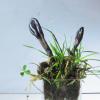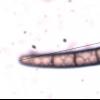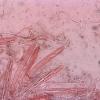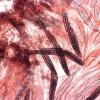
14-05-2025 10:57
 Nicolas Suberbielle
Nicolas Suberbielle
Bonjour,Encore une trouvaille de Marie-Rose D'Ange

13-05-2025 12:32
Gernot FriebesHi,I found this one on a Picea abies branch. It lo

08-07-2023 19:24
Juuso ÄikäsThese Mollisia fruitbodies were growing on a twig

02-05-2025 10:16
 Bernard CLESSE
Bernard CLESSE
Bonjour à toutes et tous,Pourriez-vous m'aider à

12-05-2025 18:52
Gonzalez Garcia MartaBuenas tardes, estoy estudiando un hongo peritecio

11-05-2025 17:57
Louis DENYHello forumTrouvé dans les environs de Belfort,al

08-05-2025 20:50
Andreas JacobGood evening, due to contstant drought I started
Geoglossum
Malcolm Greaves,
13-11-2015 13:36
Would this be within a reasonable range for the species or is there another species I should be looking at?
Thanks
Mal
Michael Beug,
14-11-2015 01:33

Re : Geoglossum umbratile
Geoglossum umbratile spore size is highly variable (30-90 x 4.5-6.5 microns). The septa in the paraphyses are not constricted while the septa in Geoglossum simile and G. pygmaeum both are constricted. Geoglossum simile and Geoglossum glabrum have paraphyses that are closely septate in the upper portions.
Sabino Arauzo,
15-11-2015 12:40
Re : Geoglossum
The asci, paraphyses and inmature spores guttulation are typical of G. fallax, but shorter spores, as HB6543 of Zotto!
Regards.
Sabino.
Malcolm Greaves,
15-11-2015 21:26
Re : Geoglossum
Thanks Michael and Sabino.
Looking at Zotto's great descriptions I think that as I could find no mature spores with more than 7 septae and the paraphyses were quite swollen I think G umbratile is more likely. I will note for future that the spores can be more variable than some descriptions say.
Mal
Looking at Zotto's great descriptions I think that as I could find no mature spores with more than 7 septae and the paraphyses were quite swollen I think G umbratile is more likely. I will note for future that the spores can be more variable than some descriptions say.
Mal
Iglesias Plácido,
16-11-2015 12:31
Re : Geoglossum
Geoglossum fallax típico.
Malcolm Greaves,
16-11-2015 16:09
Re : Geoglossum
Hi Iglesias
I have very little experience of Geoglossum so if this is typical G fallax what differences should I look out for in G umbratile?
Thanks
Mal
I have very little experience of Geoglossum so if this is typical G fallax what differences should I look out for in G umbratile?
Thanks
Mal
Michael Beug,
16-11-2015 18:34

Re : Geoglossum
My understanding of Geoglossum fallax is that it is notable for its brown rather than black fertile surface color, a finely scaly stipe, gnerally hyaline spores that only tardily become septate and turn smoky, The spores are initially non-septate, then 3-septate and finally 7-12 septa. Paraphyses are 5-6 microns, cylindric, sparingly to moderately septate, not constricted or only moderately constricted at the septa and strongly curved or coiled in the upper part. The paraphyses are very similar to those of G. umbratile. Some collections of G. umbratile are viscid. G. umbratile fruitbodies are dark brown to black




